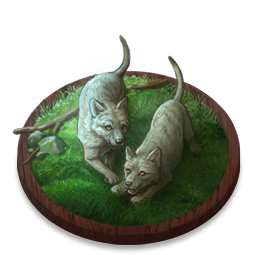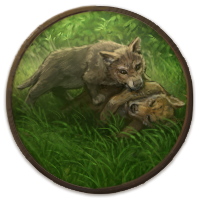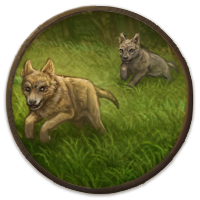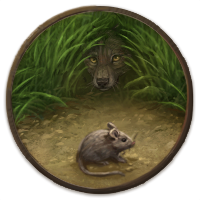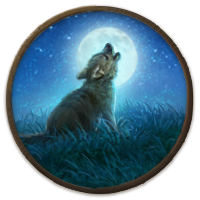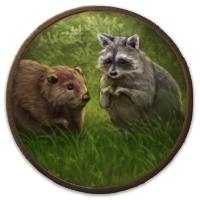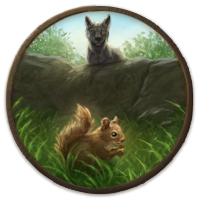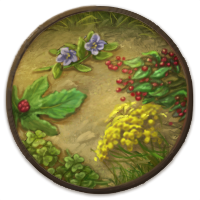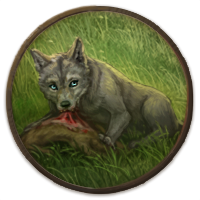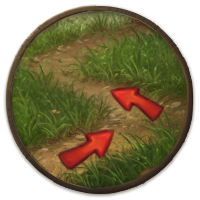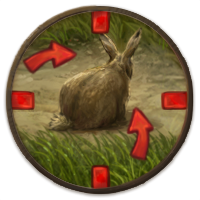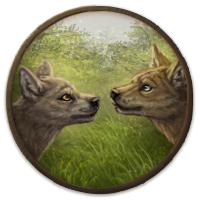Pup Basics
A wolf is considered a puppy from 0 years 0 months old until 0 years 5.5 months old. Between 0 years 6 months and 1 year old, they will be considered adolescents.
A pup will be under their mother's care for 6 days. 5 rollovers after being born, or after 6 total days under their mother's care, pups are weaned and no longer require their mother's specific care with survival. If you chase a wolf that is nursing puppies, they will take their puppies with them.

A wolf with a nursing puppy.
Rollover Penalties
While a wolf is nursing puppies, as well as while the pup is growing, it's important to remember to keep the wolves fully fed and entertained every rollover.
If a nursing mother's hunger and mood are less than 100%, the nursing puppies will suffer survival chance penalties, detailed below. After a puppy is weaned from their mother, they themselves must be fully fed and entertained lest they suffer survival chance penalties.
You should also keep a nursing mother free of illness until their pups are weaned. If the mother has a contagious illness, it is a guaranteed chance that the illness will be passed onto one of the nursing puppies every rollover until all the nursing puppies have it. You can learn about which illnesses are contagious in [this guide].

Survival change notification in a daily rollover summary.
Pupsitting & Pup Survival
As soon as they are born, pups are given a survival chance. They cannot survive without some help! Wolves younger than 6 months old can be assigned pupsitters to help ensure greater chances of survival. This is not mandatory, but is highly recommended, especially for pups you care for. Pupsitters can guarantee that a pup will survive until adolescence.
A pup's chance of survival is clearly indicated by their Survival Chance, and it is a simple chance. A pup with 60% Survival Chance has a 60% chance they will live this rollover, and a 40% chance they will die. You can view a pup's survival chance on their page.
The only way to guarantee that a pup will survive is to make sure they have 100% survival chance. Any survival chance lower than 100% still provides an opportunity for the pup to pass on rollover.

The location of the survival chance status bar.
A pup's initial survivability is dependent on a few factors. How many pups are in the litter, the mother's mood and hunger, as well as the parents' levels all contribute to initial survival chance. Higher level parents will provide higher survival chances.
Birth season also plays a large role in the survival chances a pup is born with. In the Winter, pups are born with significantly lower survival chances. In the Spring, pups are born with survival boosts. Summer and Autumn do not affect survival chances at birth.
 
Winter and Spring icons.
On any given day, the only way to instantly increase a pup's survival chance is through the use of pupsitters. Over a few days, however, you can increase the pup's survival chance naturally by keeping the nursing mother, or the pup if the pup is weaned, fully fed and entertained. If a pup is nursing and their mother is fully fed and entertained at rollover, the pup will receive a 7% boost to their Survival Chance. After the pup is weaned, they will receive a 7% survival chance if the pup themselves is fully fed and entertained at rollover. If the pup or the nursing mother is not fully fed and played with at rollover, the pup will instead suffer survival penalties.
| Rollover Survival Boosts and Penalties | | Hunger and Mood | Survival Effect | | 100% Hunger and 100% mood | +7% survival chance | | 100% Hunger and less than 100% mood | No survival change | | Less than 100% Hunger and 100% mood | -8% survival chance | | Less than 100% Hunger and less than 100% mood | -15% survival chance |
Pups can also obtain a small survival boost from completing [pup training], however this is something they can only do once per day.
Pupsitters
Any adult wolf can be made a pupsitter by selecting the role on the wolf's settings. There is no limit to the amount of pupsitters one pack can have.

Pupsitter icon.
To have a wolf protect a puppy, assign them as a pupsitter and then go to the pupsitter tab on their page. Once there, you can click Assign Puppies to move to the pupsitting menu.

Assigning puppies on a pupsitter's page.
The pupsitting menu provides a detailed overview of the pupsitter you have selected, as well as the pups they are currently protecting and any unprotected puppies currently in your pack. You can select which unprotected puppies you'd like the pupsitter to protect, or remove puppies from their protection. One pupsitter is able to protect 10 puppies at a time. The fewer puppies they protect, however, the more survival chance boost they will give to each puppy. This page is also where a pupsitter can train an adolescent if you have any available.

The pupsitting menu.
Pupsitters have a base 60% protection they are able to offer to puppies. As their proficiency increases, the amount of protection they can provide also increases. For every 25 proficiency points, the pupsitter will gain an additional 10% possible protection. This means a pupsitter at 100 proficiency will have 100% protection to provide.
The total protection is split evenly between all puppies being protected by one pupsitter. So, if the pupsitter has 60% protection and is protecting 6 puppies, each puppy will receive a 10% survival chance boost from the pupsitter.
Wolves who are actively protecting puppies will gain 5 proficiency points every rollover as well as a small amount of EXP. Every rollover they are not actively protecting puppies, they will lose 1 proficiency point until they are completely out. Even if you change a wolf's role, they will still maintain their previous pupsitter proficiency. So, if you switch a pupsitter with 75% proficiency into the hunter role, and then switch them back to pupsitter, they will still have proficiency in pupsitting, though they will have lost some proficiency depending on how many rollovers they were not protecting puppies. Pupsitting proficiency losses are listed in your Daily Rollover Summary.

Pupsitter proficiency loss in a rollover summary.
Pupsitting is hard work, and also has an effect on the wolf's energy! For every pup a wolf is protecting, they will lose 10% energy, and they will not be able to regain this energy until they are no longer pupsitting. Energy can be regenerated using Guarana, however. So, if a pupsitter is protecting 7 puppies, they will drop to 30% energy and this energy will not regain unless a Guarana is used.
Pup Death and Injury
The only way to guarantee that a pup will not die is to make sure that their survival chances are always at 100%. Any survival chance lower than 100%, even 99%, does not prevent deaths.
An important fact to note is that, during rollover, a pup's survival penalties are determined before death is rolled. If your pup is at 100% survival chance going into rollover, but they were not fully fed, they will have actually been at 92% survival (having suffered a -8% penalty from hunger), and they will still have a chance of dying that rollover. Pups also have a chance of dying at rollover if their pupsitter dies during that rollover, as they will no longer have the pupsitter protection. Inversely, a pup whose survival chance isn't 100% will be guaranteed to survive if the boosts they receive on a rollover will increase the survival chance to 100% on that rollover.
If a puppy dies on rollover, you will receive a notice of it in your Daily Rollover Summary, and the puppy will be sent to your dynasty. The death text in the death announcement is completely random flavour text.

Pup death notification in a rollover summary.
Puppies without full survival chances also have the chance of being injured on rollover. If a puppy gets injured, they will lose a little bit of HP and they may even contract illnesses. Injuries are a sign that a pup is not protected enough.

Pup injury notification in a rollover summary.
Just like with adult wolves, pup can also die from lethal illnesses. One illness, however, is only lethal to puppies. If a pup contracts Pox, it will die the next rollover no matter what its survival chances were.
Runts & Largest Puppies
Depending on litter size, with larger litters having a higher probability, there is the chance of runts and largest pups being born. Upon birth, these pups will be named either "New Largest Puppy" or "New Runt Puppy". The largest puppy is usually the puppy with the highest stats and will be given a survival chance boost. The runt puppy will be the opposite, being the one with the lowest stats and given a survival chance penalty. Both largest puppies and runts will gain additional stats and survival chance just the same as any other wolf and their status will not affect them as they age.

A runt puppy.
The rates of runts/largest puppies appearing in a litter of a certain size are as follows:
- 1-2 pup litter: 0% chance
- 3 pup litter: 10% chance
- 4 pup litter: 20% chance
- 5 pup litter: 30% chance
- 6 pup litter: 40% chance
|



































